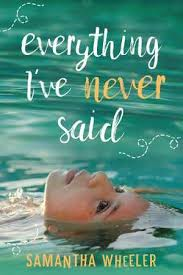Every so often, a book comes along that touches your heart in places so tender it hurts. A book that makes you cry because of the frustration and sadness in the world, but also makes you laugh out loud with joy because of small kindnesses and the many sources of happiness that are to be found despite the pain. Everything I’ve Never Said (UQP 2018) by children’s author Samantha Wheeler, is such a book, a beautifully simple story for both young people and adults that features a disabled protagonist on a quest to have her voice heard.
Samantha writes from lived experience – one of her own daughters has Rett syndrome, a rare genetic condition which means she has little or no control over the muscles in her body. The girl at the centre of this story, Ava, understands everyone and everything around her – there is nothing wrong with her intelligence – but she needs assistance to eat, to swallow, to walk, to even move her hands the way she wants to. But most importantly of all, she cannot communicate. Her head is full of words and wants and opinions, but she can’t express them. She is locked into her body. Her only way to get attention is to scream or bite or pinch, actions that come involuntarily when she is distressed, not because she does them on purpose (or, not always, anyway!)
Samantha has taken the character of Ava and given her a voice. Ava speaks to us throughout the book – the story is told by her, in first person. We are privy to her frustration with her own body and its limitations. She shares with us all of the things she has thought, but never said.
This book gave me a profound insight into Rett syndrome and similar conditions. Ava is an extraordinary young girl – feisty, smart, cheeky, loving and caring. How cruel for such an adventurous spirit to be bound in a physical body that only constricts and restricts her.
Ava lives with her sister Nic and their mum and dad. Right from the first pages of the story, we engage with Ava and her remarkable character. We see her disability, certainly – it is evident in every thought she has and every action she tries to undertake. But we also see her abilities – her teenage similarities to her sister, her bright mind always trying to figure out a way to make herself heard. When tragedy strikes the household, Ava – and her family – are forced to confront her challenges head-on. She meets an occupational therapist who is determined to hear her, and she makes a new friend, Aimee, who uses a speaking machine. Aimee is a wonderful character – naughty, sassy and mischievous – and for the first time, Ava realises that there are others like her, with bold intellect and quick wit hidden in an unreliable and unpredictable body.
This book is written for a young reader, and the issues and language are entirely appropriate. But the story itself is for everyone, young or old. Adults will empathise with Ava’s parents as they struggle with parenting; adolescents will recognise Ava’s older sister Nic’s defiant streak and her search for belonging.
The cover of the book shows a girl floating. This is one of the few times that Ava feels truly herself – cocooned by the warm water, weightless and free, unencumbered by her recalcitrant body. As the story develops, and Ava faces the judgement of those in authority, the discrimination of strangers and the exasperation and weariness of her family and friends, we find ourselves silently cheering her on in her quest to be heard. For somebody who can’t talk, Ava has an awful lot to say! Her sense of humour, and her caring and loving nature, despite the challenges that face her, are inspiring.
Reading breeds tolerance and understanding, and this story certainly does that. Give it to your children to help them understand people with disabilities, read it yourself to understand what can be done, and how much further we have to go. My first purchase will be for a young man I know with cerebral palsy who I interviewed recently – another young person who believes that just because you have no voice, doesn’t mean you don’t have something to say.
Samantha Wheeler is well-known for her children’s books that champion environmental action and Australian animals. This book feels like something different, something special and very personal. This story comes from the heart, and it has a lot of heart. I hope that many children like Ava can read it, or have it read to them; I hope they can recognise themselves and capture sparks of hope.

